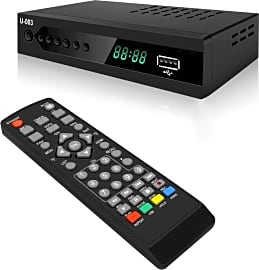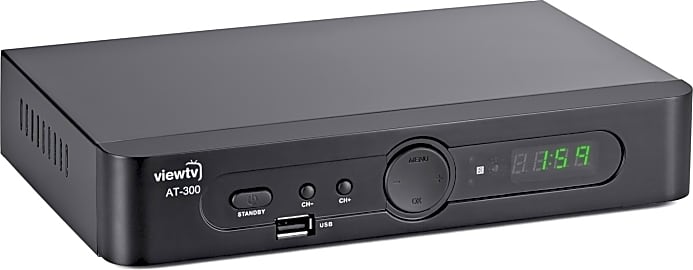The 8 Best Digital TV Converters

This wiki has been updated 36 times since it was first published in October of 2016. If you have an older television and want to receive local channels without paying a huge cable bill, then you'll need one of these TV converters. These handy boxes change today's over-the-air digital signals into an analog format, and are available with a host of useful additional features, such as DVRs and USB connections. Our picks include some of the best and latest models on the market When users buy our independently chosen editorial recommendations, we may earn commissions to help fund the Wiki.
Editor's Notes
January 26, 2021:
Antennas themselves won’t discriminate between digital and analog channels, though most OTA channels have switched to digital format in recent years, meaning that they tend to broadcast on the UHF band, and the way they send data is also different, and a lot more efficient – data is sent in packages and takes up less bandwidth than analog transmission.
As analog TVs can only display 480i, the maximum support resolution may largely be irrelevant in the vast majority of applications, unless you're using a computer monitor or other digital display. That’s why I’ve focused less on including models based on their display specs and other technical features, and more based on durability and removing models with other issues, as poorly designed devices are often prone to overheating, and is one of the reasons I’ve removed the Leelbox models, despite being fond of the brand myself, and added off-brand models like the Ubisheng U-003 instead. Common secondary features of DTAs (Digital TV Adapters) – also commonly known as converter boxes or decoder boxes – include recording and scheduling capabilities, a built-in clock, program guide, and support for closed captions and multiple languages – in fact, these are virtually standard on these devices, though the level of sophistication of each of these features may vary from model to model.
December 31, 2019:
The first model I removed during this update was the highly overpriced and clearly outdated Zinwell ZAT-970A. All modern digital TV converters can (and should) at least feature a USB slot to enable playback and recording via an external hard drive, and also be able to support 1080P and Dolby Digital audio.
These features are pretty standard nowadays, and unfortunately, the Zinwell doesn’t have any of these. This is one of those examples where you have to exercise some discrimination, since most of the positive hype and customer feedback surrounding this model still exists on the internet and continues to influence people about the choice of this product based on a time when it probably was a much ‘better’ model, relatively speaking.
Aside from removing the Zinwell, I’ve removed some of our older picks, like the Boostwave Converter, 1byOne ATSC and iView 3500STBII and replaced them with 3 excellent models that offer similar features and have been released within the past year - the Leelbox S3, the Sindave Converter and the Leelbox F6.
The Bunny Aerial: In Memoriam
There were comedies and dramas, cartoons and music videos, and there was Bob Ross.
A long, long time ago (the 1990s), in a world very different from ours today, analog signals flooded the atmosphere and even our very homes. These were beamed from every individual network's transmitter to our houses on designated frequencies. They carried on their VHF and UHF-banded wavelengths the cutting edge of American entertainment, crisp color pictures accompanied by brilliant stereo sound. All of this wonderful analog data was captured by the classic rabbit-ear antennas we all remember so fondly. There were comedies and dramas, cartoons and music videos, and there was Bob Ross. It was truly a beautiful time in American history.
And on the morning of June 12th, 2009, it all came to a sudden stop.
Well, not television itself, of course. But the transmission of full-power analog signals did stop on that fateful summer day many years ago. In fact, it stopped thanks to a legal order via the FCC, put forth to help usher in the era of accessible, high-definition broadcast television. To that end, analog TV simply had to go.
But there's one problem. It's not that people miss low-quality, easily-corrupted telecasts. Obviously, readily available HD programming is the way of the future — it looks and sounds better, is more versatile, resists interference, and takes less power to transmit. The issue is simply that there are a lot of great TVs and projectors out there that can't decode public television anymore. All it would take is an updated tuner for those devices to take advantage of today's superior signals. And that's where digital TV converters enter the picture.
We've Come A Long Way
Ever since John Baird pioneered long-distance broadcast video in the late 1920s, engineers around the world have sought to advance the visual and audio quality, channel availability, and overall watchability of publicly available television. Human ingenuity has led to incredible developments such as color TV, widely accepted NTSC standards, and ever-stronger transmission towers. In the 1990s, it became apparent that a huge step forward in broadcasting technology was imminent. Using the newest, smallest, fastest chipsets, digital television arrived. This new practice became widespread by the 2000s, with far-reaching effect.
By that year, all new sets would come standard with the modern style of tuner.
More people than ever began cutting cords, that is, stepping away from subscription-based services and relying mainly on free broadcasts for news and entertainment. By 2016, it was estimated that up to 20 million TV-owning households consumed new media using only their HDTV antenna. The new standards brought to high- and low-income families the same sharp images and modern shows. Travelers who lived in RVs could access local channels with increased ease, helping them keep up with the rest of society. But there was one major drawback for many households: their TVs didn't work anymore.
Before 2007, many TVs were produced without the inherent ability to decode a digital TV signal. By that year, all new sets would come standard with the modern style of tuner. But by two years later, when the switch occurred, many perfectly good home TV sets, projectors, and home theater units could no longer pick up network shows. This was such a big deal that the US government even issued a voucher to families toward the cost of a digital TV converter. Encouraging people to avoid purchasing a brand new television, this also helped to fight another big problem with modern electronics: pollution.
The cost of disposing of some electronics is high, thanks to their use of toxic elements like lead, cadmium, and barium. Initially, this made it difficult in some areas to find recycling facilities willing to accept old sets. In fact, many thrift stores stopped accepting analog units around the time of the switch, because they were so hard to get rid of. So, by using a digital converter box, you're not only saving your pocketbook but also helping to save the planet. Doesn't that make you feel good?
Sounds Great! What Are My Options?
There are a number of features you'll encounter in various forms across the field of digital converter boxes. You'll find numerous output formats on various models including HDMI, coaxial, component, and RCA. These varying formats make some converters compatible with older TV sets that have very limited inputs. A lot of boxes have signal strength meters and parental controls available. Most of them offer an interactive guide that takes advantage of the data transmitted alongside HDTV video and audio, while offering the user complete control of the unit through customized settings.
A lot of boxes have signal strength meters and parental controls available.
Some advanced units include DVR capabilities, letting you pause the action and restart it at your leisure, as well as giving you the ability to record your favorite shows. Similarly, a lot of digital TV adapters can connect to external storage via USB cable, giving you access to your entire collection of archived media. At the end of the day, make sure that whichever model you choose is capable of true 1080p video, so you can take full advantage of the high-quality video feeds now standard across the airwaves.
You'll get many more years of life out of your current television while streamlining your media usage when you select the right digital TV converter to suit your needs. As with most electronics, there are many different options available, with a multitude of powerful features. Finally, don't forget to use a good antenna to pick up all your signals cleanly.













